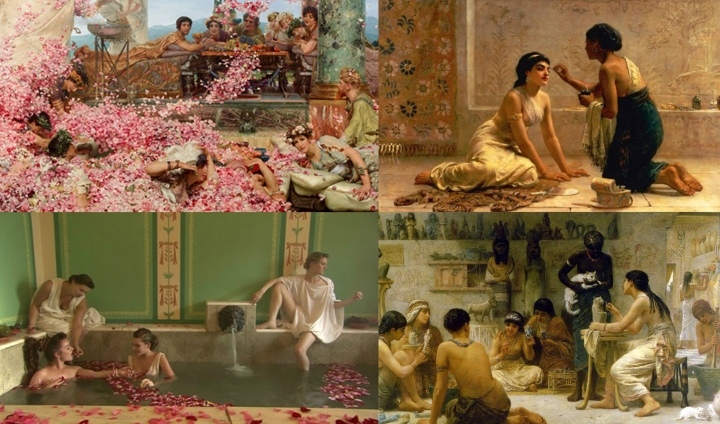
ANCIENT GREEK RITUALS FOR THE HAIR
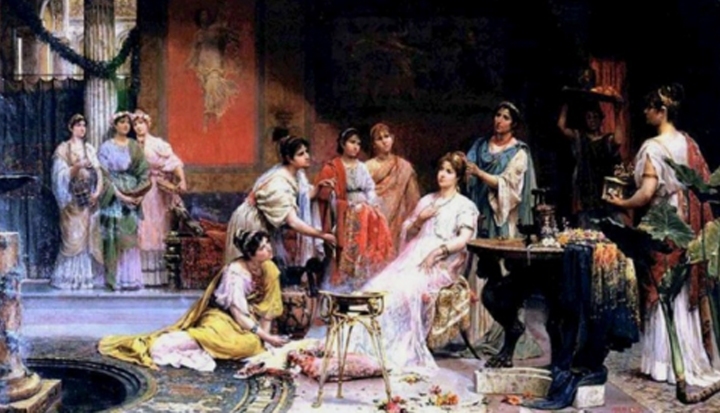
The Greeks were big lovers of physical beauty. They were very in tune with the body’s natural aging process, thus they were always seeking ways to improve their appearance. The word “cosmetics” actually comes from the Greek word ‘kosmetikos’, originating in the 17th century.
Aphrodite, the olympian Greek goddess of love and beauty, created a quintessential beauty ideal among Greek women. This goddess symbolised true femininity and grace, which perhaps influenced the Greek’s prestigious, ancient beauty rituals.
The Greeks favoured light complexions, which they maintained using white lead. This was later replaced by chalk powder around 1000 BC due to the many deaths caused by slow lead poisoning.
Crushed mulberries were used for lip and cheek stains, as was clay and red iron for lip color. Dark eyeshadows were also favoured, made using a mixture of charcoal and oils. Fake, thick and prominent eyebrows were made with the hair of oxen. Often times, women even preferred connected eyebrows , as this was admired in their culture.
Both honey and olive oil were used in many cosmetic and anti-aging preparations. It is said that the wild olive tree originated in ancient Greece, so this tree, along with its plethora of beauty benefits, was considered sacred. Women anointed themselves in olive oil to protect their skin from environmental stressors, and it was used in facial masks to promote a clear looking complexion. Honey was also mixed with olive oil to help lighten the appearance of skin.
Today’s beauty formulators definitely learned a thing or two from Greece, considering olive oil and honey are still heavily used in natural skin care treatments. The women of Greece were all about enhancing their features, long hair and a fair complexion. Some of their styles were intriguing. They had different styles to represent their status. For example, married women would mostly wear their hair tied up in a bun accessorised with flowers and jewels. Whereas young women would curl their hair and let them flow freely to attract attention from men.
There is a reason why an exceptionally beautiful woman is called a “Greek Goddess“. So let’s find out their secrets… It is said that the tree of Olives first grew in Ancient Greece. It was considered as a sacred tree because of their numerous benefits to health, skin and hair. The athletes were crowned with its leaves to honour them. They applied olive oil on their skin to protect it against sun damage.The barrier of oil also kept the dirt from clogging their pores. The leaves of olive trees were crushed to make a facial paste or mask for skin. It helped the young women relieve their skin from spots and acne.
According to the Ancient Greeks, the appearance was directly linked to the soul and the mind, so beautiful people were automatically perceived as good and intelligent, too. Athletic male body was particularly worshipped, achieved at the cost of prolonged physical exercises. The ideal of the female figure was the statues of the goddess of beauty Aphrodite, whose measures 86/69/93 (bust / waist / hips) are very reminiscent of those that until recently were regarded as perfect in the fashion circles.
The Greeks preferred light color not only in terms of complexion, but also in terms of hair. Their standard for perfection again conflicted with the physical characteristics granted to them by Nature. To bleach themselves, the ancient aesthetes generously poured vinegar or lemon juice over their hairs, then stood in the sun to activate the “dye” This procedure, however, often proved to be too aggressive to the hair and required a subsequent use of restorative therapies. Then, the Greeks resorted to the miraculous power of plant oils, which quickly repaired the damages. The recipe for one of their favorite hair masks is still current nowadays, thanks to its excellent fortifying properties and its simple and affordable ingredients, eggs and olive oil.
There are lots of hair mask recipes out there for every type of hair and every kind of hair problem. This first recipe is the most basic, containing only olive oil. The amount may need to be adjusted depending on the length and thickness of your hair. As the recipe suggests, you can add some drops of the essential oil of your choice, though it’s not necessary. We’ve recommended rosemary oil because it stimulates the roots, improves hair growth, and increases circulation in the scalp.
Olive Oil, Honey, and Banana Smoothie Hair Mask
This hair mask recipe sounds as good to eat as it is for your hair! If your hair is very dry, you can apply this mask twice a week until it has been restored to its natural shine and health. In addition to olive oil, this mask contains a few extra hair health-boosting ingredients. They’re all natural and the perfect compliment to the healing powers of “liquid gold”.
Honey: Honey is an emollient which means it is a natural softener and it also improves the health of the hair follicles which are responsible for hair growth. Researchers say that proper use of honey of treatment of hair can waken up the sleeping hair follicles which boost the growth of hair. Honey is also a natural antioxidant, so it will make your scalp healthy and stimulate hair growth. Finally, honey’s high sugar content helps your hair retain moisture.
Banana: Packed with potassium, bananas are great for strengthening and thickening fine hair. Bananas nourish the scalp and hair follicles, help maintain natural hair elasticity, and prevent breakage and split ends.
Milk: Milk contains several nutrients such as Vitamin A & B, phosphorous, calcium, magnesium, zinc and protein that have the ability to strengthen and fortify cells, and this includes hair cells. Milk is especially useful for hair that is prone to being frizzy and dry. It conditions, moisturizes and adds shine to hair.
Egg: Eggs are rich in protein, vitamins and fat—perfect for nursing dry hair back to health. Eggs nourish, moisturize, and lubricate dry damaged hair. For damaged hair, egg yolk will strengthen hair follicles and roots. Powerhouses for deep conditioning, eggs soften hair, revitalize it, and transform it back into silky smooth locks. Egg yolks can also prevent hair loss.
Ingredients:
- 1 ripe banana
- 1 egg
- 3 tablespoons milk
- 3 tablespoons honey
- 5 tablespoons olive oil
ANCIENT ROMAN BEAUTY RITUALS FOR THE FACE
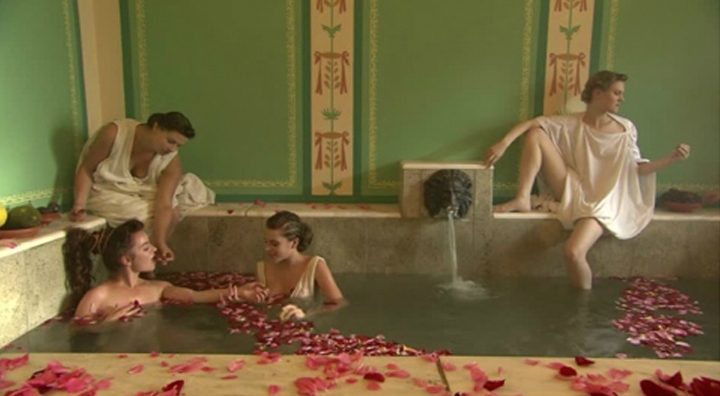
Hopping over to Rome, specifically around early 100 AD, the Romans from this era and those that followed loved their bathing rituals. In fact, the Romans created such opulent bathhouses, they are quite comparable to our modern day spas.
The bathhouses were beautified with mosaics, paintings and intricate ceilings flooded with natural light. In these gender-segregated oases, bathers engaged in contrast bathing therapy, also known as hot/cold immersion therapy. Bathers would then follow their treatment with the use of an instrument referred to as a ‘strigil’. This curved metal tool was used to scrape dirt and sweat from the body before steam therapy, body scrubs and massage.
And what was a bath to an ancient Roman without fragrance to top it off? Perfumes were very popular, and were formulated using a variety of flowers and herbs like saffron, almonds, rose petals, lilies, myrtle, laurel and jasmine.
Similar to the Greeks, Romans of this era also preferred fair, white complexions, for which they used white lead, white marl and chalk powder to achieve. Rouge, in the form of mulberry juice, wine dregs, rose and poppy petals, red chalk and even crocodile dung, was applied for cheek color.
Other unique rituals included using barley flour and butter to soothe skin. Nail color was made using animal fat and blood, creating a pink and red tint.
The fall of the Roman Empire nearly caused the “vanishing” of all cosmetics, and it became very uncommon to wear make up there for a bit. But around 1200 AD, makeup was slowly reintroduced into the culture and the beauty rituals lived on!
Ancient Roman women often used beauty masks made from “sweat from sheep’s wool” and other ingredients like “juice, seeds, horns, excrement, honey, plants, placenta, marrow, vinegar, bile, animal urine, sulfur, vinegar, eggs, myrrh, incense, frankincense,ground oyster shells, onions with poultry fat, white lead, and barley with vetch.”
Roman Beauty Mask
Seeds, honey, and eggs I can dig. The other stuff, probably not so much. That doesn’t mean beauty masks aren’t a great idea though. I’ve made my own masks in the past and this lemon and egg white mask from The daily green has an excellent mask that tones and tightens your skin.
Ingredients:
- Juice from 1/2 a lemon
- 1 egg white
Application:
Beat together the egg white and lemon juice for 3 minutes. Apply directly to your face, avoiding the eyes. Leave on for 30 minutes. Rinse off with warm water.
ANCIENT EGYPTIAN BEAUTY RITUALS FOR THE BODY
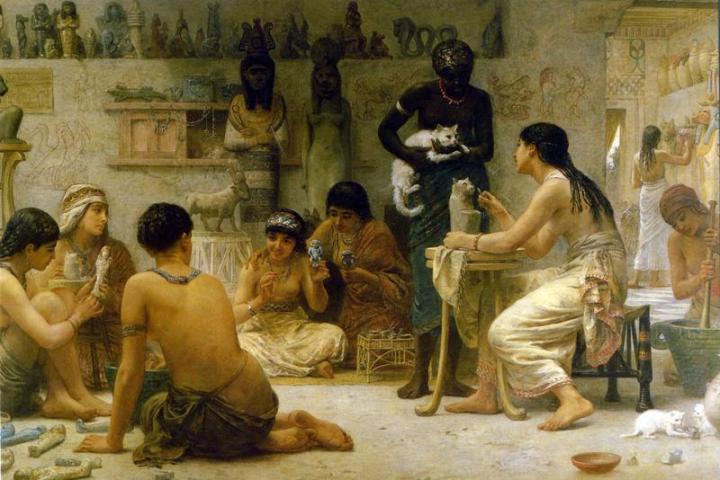 Not only was ancient Egypt one of the most advanced civilizations to grace the earth, but also the creator of many sacred luxuries that are still used widely today. Egyptians were undeniably known for their “bling” and were, without a doubt, stylishly avant-garde.
Not only was ancient Egypt one of the most advanced civilizations to grace the earth, but also the creator of many sacred luxuries that are still used widely today. Egyptians were undeniably known for their “bling” and were, without a doubt, stylishly avant-garde.
Adorned in exotic jewelry, headdresses and hairstyles, Egyptians took fashion and beauty quite seriously. Sulfites (kohl) and malachite minerals were used as eye enhancements and liners, while lip color was made with purple and red dyes from seaweed, iodine and carmine beetles.
Uncovered burials have provided us with artifacts and knowledge that beautification rituals were revered in Egypt more than in any other culture. For example, burials and tombs have been discovered with remnants of cosmetics inside. The application of makeup was so important to ancient Egyptians and pharaohs that their beauty rituals served as an honor to their gods and goddesses.
Speaking of Pharaohs… Cleopatra, the last active pharaoh of Egypt, was a legendary beauty, leaving behind timeless rituals with her legacy. Almond oils, apple cider vinegar, dead sea salt scrubs, honey and milk baths were among some of her anti-aging rituals.
As early as 10,000 BCE, moisturizing emollients were being used in Egypt to protect the skin from the very dry desert climate. According to the author Judith Illes, who has done extensive research on ancient Egypt, Egyptians had access to and used, more or less, 21 different vegetable oils for a range of beauty purposes. Both men and women applied oil to their bodies regularly.
Perfumes were also prized in ancient Egypt, as they were valued for their positive health and wellness properties. Frankincense and myrrh were highly regarded as essential ingredients in perfumes, skin care treatments, dental hygiene and insect repellent. These resins were also a sacred component of the embalming process for the deceased.
Since Egyptians embodied cleanliness, hair removal was a fundamental part of their grooming habits. Sugaring, a natural method of hair removal, was performed using a sugar solution made with sugar, lemon and water to form a paste. The paste was applied to the hair, without sticking to the skin, and “flicked” off. It’s truly a fascinating method that still exists today and is gaining popularity among estheticians.
We could go on and on about ancient Egypt’s extraordinary beauty rituals; they were the pioneers of an authentic concept of beauty.
Cleopatra Honey Scrub
Let’s start with one of the most legendary beauties of all time – the woman who made the hearts of both Caesar and Marc Antony go pitter pat. Known throughout the Mediterranean world for her goddess-like appearance, archaeological evidence indicates that Cleopatra and many other Egyptian head turners might have had a little help.
In addition to the extravagant and expensive practice of bathing in milk and honey, women of Egyptian royalty used a variety of natural creams, masks, and exfoliants. Below is a skin scrub formula that was recently discovered on a piece of medical papyrus dating back to the court of Thuthmosis III (1425 BC). Someone was so enamored by this prized formula that they asked for its recipe to be buried with them – if that’s not a rave review, I don’t know what is!
Ingredients:
- 1 part Honey
- 1 part Natron – naturally occurring mixture of alkaline sodium salts (or use baking soda as a substitute)
- 1 part Lower Egyptian Salt
In addition to the above ingredients, essential oils were most likely added to this base to give it a pleasant aroma and further medicinal qualities. Frankincense and myrrh essential oils were treasured in Ancient Egypt and were likely used in formulas like this. Just a few drops will do!
Making the scrub:
Grind all of the ingredients together thoroughly, let set for 20 minutes and apply when ready. This scrub would have been rubbed onto the skin and left on for a few minutes, before being washed off with warm water. Remember, always try homemade treatments like this on a tiny patch of skin first to make sure you don’t have any allergic reaction to them.
ANCIENT AYURVEDA BEAUTY RITUALS FOR THE SKIN
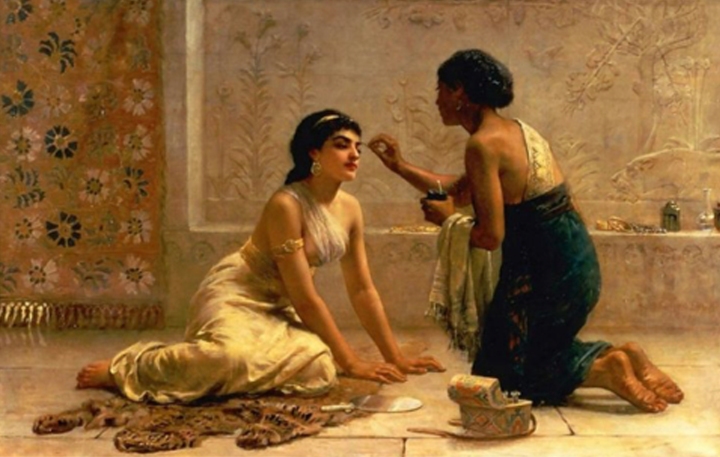
For thousands of years, Indians have believed that the body is a temple. They worshipped the earth and it’s elements, understanding the connection between nature, health and beauty.
Ayurveda is the science of life and India’s 5,000 year old holistic health care system. This complex, yet practical system is based on the belief that optimal health is achieved when your mind, body and spirit are aligned with the universe.
It’s no wonder that Indian women are of immeasurable beauty; their focus on balance and well-being mirrors their physical beauty.
Ayurvedic beauty rituals included bathing and oil treatments, which promoted physical and spiritual cleansing. Ancient Indians believed that if you couldn’t eat it, it didn’t belong on the skin. So, basically their skin care was edible and derived from the most nutritious herbs and oils around. Herbs like neem, tulsi, turmeric, sandalwood, saffron and amla were incorporated into masks, creams and the widely used sesame oil. Indians were also keen on oil pulling for dental hygiene, and dry brushing their skin for exfoliation and lymphatic stimulation.
The ancient art form of henna, also called “mehndi”, had many cultural uses. Henna refers to the dye derived from the henna plant (Lawsonia inermis). This dye was used to create decorative designs on the body for self-expression, temporary tattoos, in celebration of special occasions, traditions, ceremonies and performances. Since makeup was considered ‘superficial’ to Indians, they harnessed more natural expressions of beauty through henna and bejeweling.
There are many ancient cultures that we did not mention in this article, respectively. From the Far East, to Central and South America and Africa to Polynesia, all of these cultures defined their own authentic forms of beauty.
Since nature’s gifts were the only option for ingredients back then, it’s interesting to think that in our modern day world we are making our way back to the roots of these ancient beauty traditions.
In this pivotal time in the beauty industry, manufacturers and consumers are becoming more educated and conscious when it comes to skin care. We’ve been through a vicious cycle of industrial chemicals in our self-care products and we’re happy to see people making the switch to more botanical based lines inspired by ancient practices.
The next time you decorate your face or soak in a warm bath with essential oils, remember where all of these rituals came from. Give thanks to the founders who intuitively employed earth’s abundance. In a way, it connects us all with a healthy vision of beauty.
Ayurvedic Skin-Toner
Some of the remedies we dig up are pretty bizarre, but others like the skin toner below just make sense. Examine the three ingredients that make up this powerful skin mask – each one of them packs a medicinal wallop.
Goat yogurt, the base of this recipe, is back in mainstream use due to its pro-biotic potency and nutrient density. The peppery turmeric is a strong anti-inflammatory that is high in anti-oxidants – currently praised by natural and clinical doctors as a super-herb (particularly for its favorable effects on cancer cells). And the fragrant sandalwood tree has a long documented history of use in beauty formulas, both for its delightful aroma and its desirable toning effect on the skin. In addition to balancing out the oils on the skin, this toner has antiseptic and antibacterial qualities and functions as a gentle cleanser.
Ingredients:
- 3 tsp goat yogurt
- 1/2 tsp turmeric powder
- 1/2 tsp sandalwood powder
- Making the mask:
Simply mix all the ingredients together and let stand for 1/2 an hour in the refrigerator. Apply it to your face and wash off with warm water after 10 minutes.

